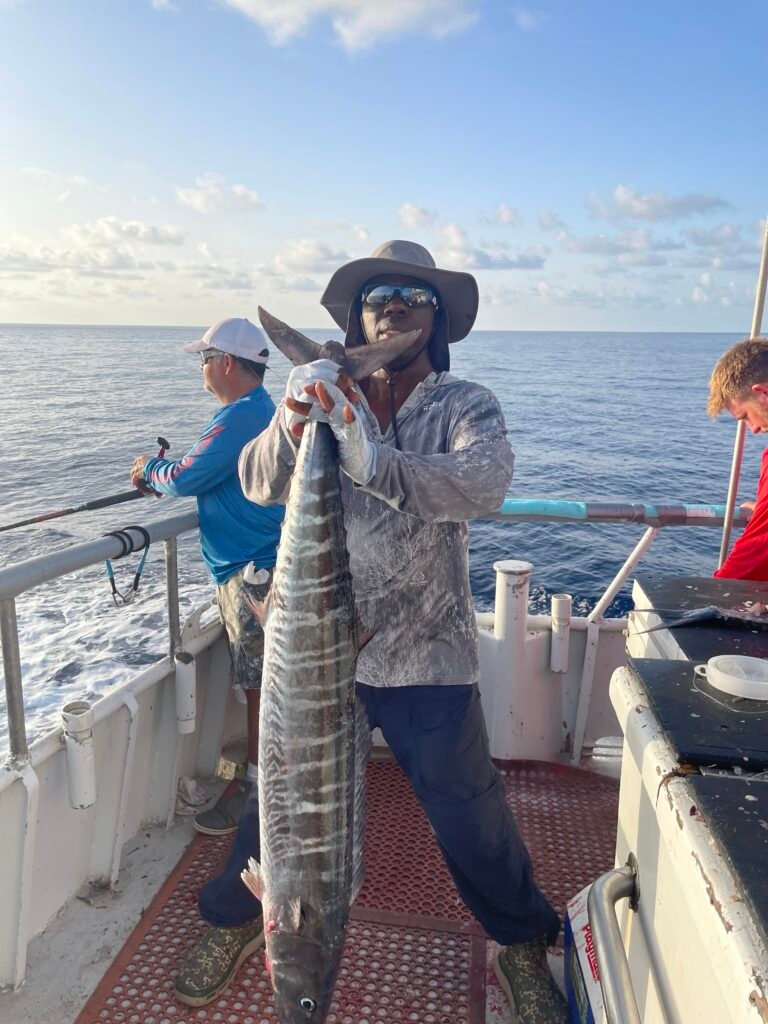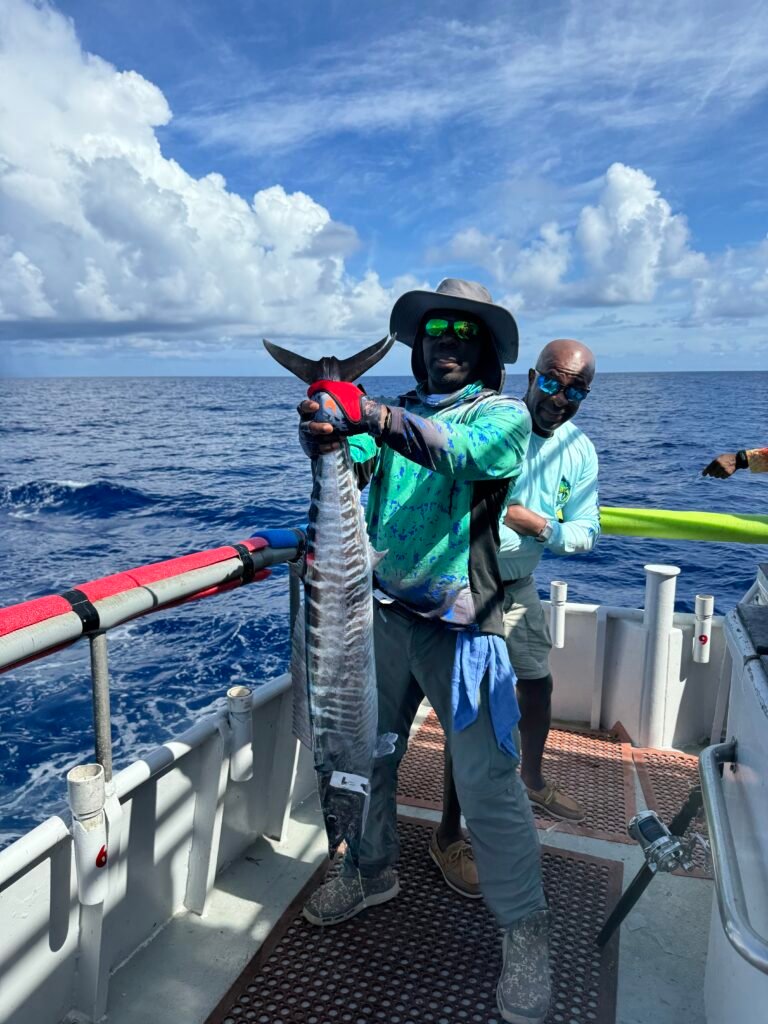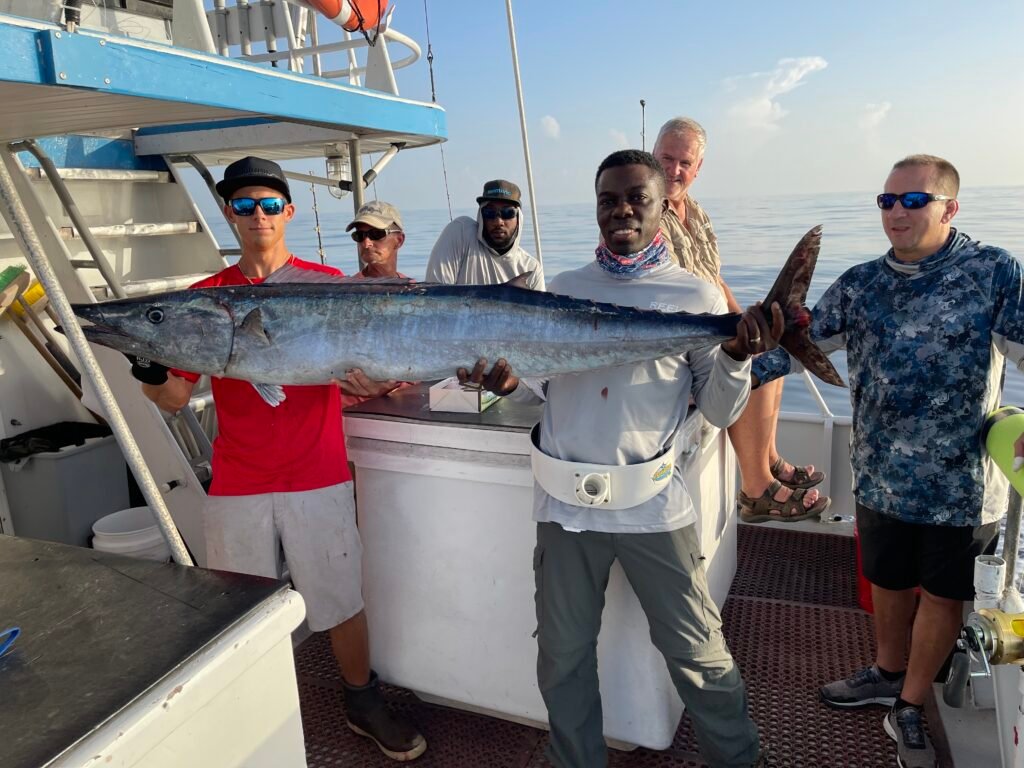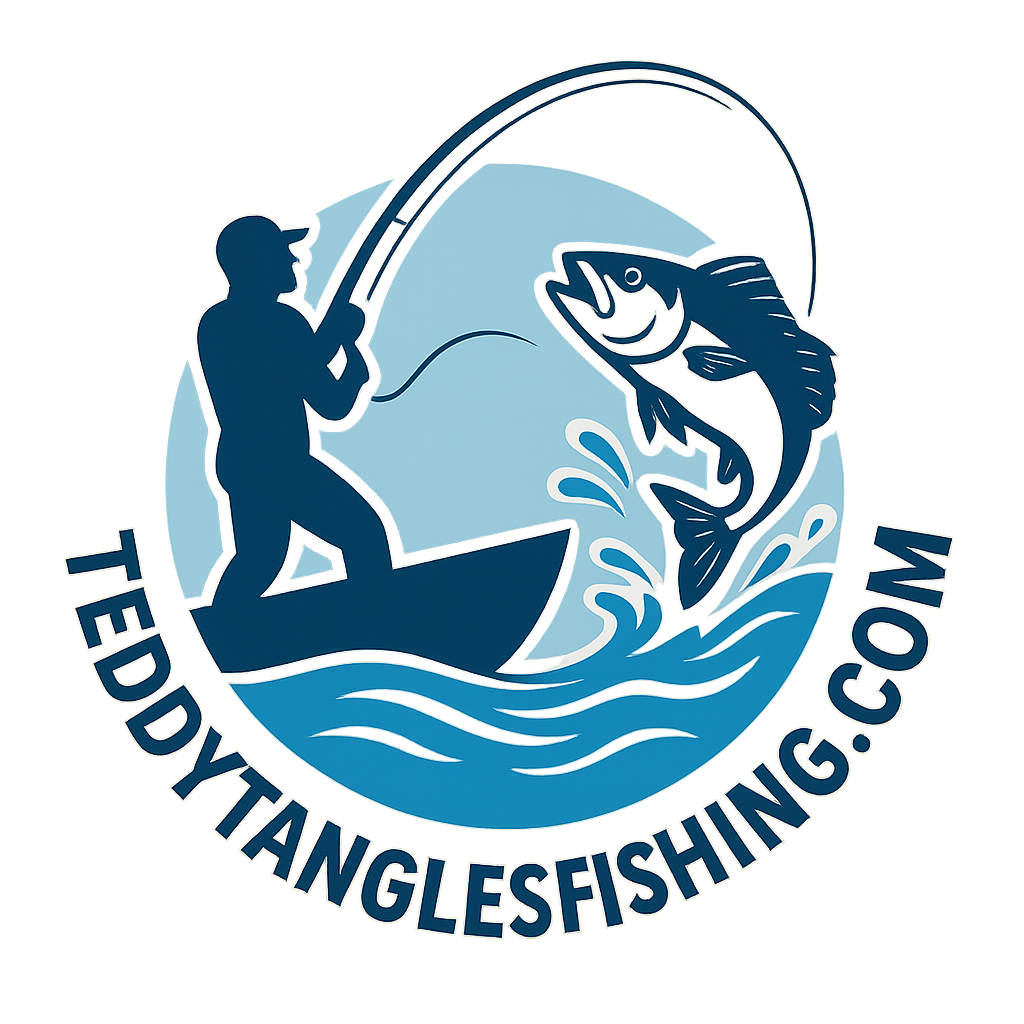Wahoo fishing demands the right lure to catch this fast and powerful fish. The 5 best lures for wahoo fishing combine speed, shine, and movement to attract strikes. Knowing which lures work best gives anglers a clear advantage on the water.

Choosing the right lure depends on factors like water clarity and fish behavior. Using lures that mimic baitfish and create flashy action helps trigger attacks from wahoo. Anglers who pick the right gear spend less time guessing and more time catching.
Understanding how to present these lures effectively increases the chance of success. Proper lure choice and technique go hand in hand for a productive wahoo fishing trip.
Key Takeways
- The best lures mimic baitfish with bright colors and fast movement.
- Presenting lures at the right speed and depth improves strikes.
- Picking the right lure depends on local water and fish conditions.
Top 5 Wahoo Fishing Lures
The best lures for wahoo have strong colors, fast action, and good weight to reach deep waters. These lures combine speed, durability, and flashing patterns to attract wahoo in open sea conditions. Each lure offers unique features to improve chances of a successful catch.
Yo-Zuri Bonita
The Yo-Zuri Bonita is popular for its lifelike swimming action and strong build. It features a sharp, realistic finish with reflective scales that flash under sunlight. This helps draw the attention of wahoo in clear water.
It weighs enough to reach fast-moving wahoo at deep depths. The lure is balanced to swim straight and fast on a trolling line. Many anglers appreciate its durable hooks that hold well during hard strikes.
Williamson Big Game Catcher
Williamson Big Game Catcher is designed to mimic small baitfish. Its slender shape and vibrant colors make it effective for wahoo that hunt by sight. It produces a strong wobbling movement, which attracts aggressive strikes.
The lure is heavy and streamlined, allowing it to dive quickly at varied trolling speeds. Its large, sharp hooks improve hook-up rates with wahoo. This makes it a reliable choice on long fishing trips.
Nomad Design DTX Minnow
The Nomad Design DTX Minnow offers a subtle but fast action that mimics injured fish. Its slender profile and natural colors fit well in different ocean conditions. The lure is semi-translucent, which provides a glowing effect in the water.
It is durable and has excellent hook placement to prevent losing fish during the fight. Anglers use it when targeting wahoo in clear or slightly murky waters. The DTX Minnow is versatile for both trolling and casting.
Rapala X-Rap Magnum
The Rapala X-Rap Magnum stands out for its aggressive darting and high-speed hook sets. It has sharp internal rattles that make noise to draw wahoo from a distance. Its reflective finish generates strong light flashes.
This lure is built to handle the force of fast trolling while keeping a lively swim. Heavy enough for deep water, it is favored for its reliability and solid hook strength. The X-Rap Magnum is a solid option for experienced anglers.
Black Bart Pelagic Breakfast
Black Bart Pelagic Breakfast combines a classic design with heavy weight for lasting power. It has bold colors and a strong, tight wobble that mimics baitfish fleeing predators. The heavy chrome finish increases visibility in deep water.
The lure’s weight allows it to reach great depths quickly. It has a strong hook system designed to hold large, strong fish like wahoo. Anglers value this lure for its toughness and consistent performance during long trolling sessions.
Key Features of Effective Wahoo Lures
Effective wahoo lures have specific qualities that help attract this fast and aggressive fish. The right shape and size, color patterns, and the lure’s action in the water all play important roles in catching wahoo.
Optimal Shape and Size
Wahoo lures usually have slim, elongated shapes that mimic baitfish like mackerel or small tuna. This shape allows the lure to cut through the water easily and move quickly, which is important for triggering a strike.
Sizes often range from 7 to 12 inches. Lures in this size range match the natural prey of wahoo and are easy for the fish to attack. Too large or too small can make the lure less effective because it won’t look like typical prey.
A streamlined profile also helps in long-distance casting or trolling, keeping the lure steady and lively at higher speeds.
Color Patterns
Color is a key part of wahoo lure effectiveness. Bright colors like blue, green, and silver stand out in clear ocean waters where wahoo usually hunt.
Reflective surfaces or holographic finishes mimic the flash of real baitfish scales. This flash attracts wahoo from afar, especially when sunlight hits the lure.
Some lures combine multiple colors or include subtle patterns like stripes or spots. These patterns add realism by breaking up the lure’s shape and making it look like a natural fish.
Action and Vibration
Wahoo respond well to fast-moving lures with tight, rapid side-to-side action. This movement simulates the quick, darting runs of prey fish.
An effective lure vibrates strongly in the water. Vibration can catch the fish’s attention, even in murky or deep water where visibility is low.
Lures that flutter or spin slightly create extra water disturbance and noise. This sensory input triggers wahoo to strike aggressively.
Overall, action and vibration work together to make the lure seem alive and easy to attack.
Best Techniques for Presenting Wahoo Lures
To catch wahoo, anglers must focus on how fast they troll and the type of leader and rig they use. These details affect lure action and help avoid losing fish to the wahoo’s sharp teeth.
Trolling Speed Strategies
Wahoo prefer lures trolled between 12 and 20 knots. Slower speeds reduce lure flash, while faster speeds increase lure vibration, attracting wahoo. Most anglers find that trolling around 15 to 18 knots gives the best balance.
Speed changes can trigger strikes. Sometimes a quick burst or slowing down for a few seconds causes a wahoo to hit. It’s important to keep the lure swimming straight and at the right depth.
Using downriggers or planer boards helps control depth and spread of lures at high speeds. Trolling multiple lures at different speeds and distances increases chances of success.
Leader and Rigging Choices
Wahoo have very sharp teeth, so strong, abrasion-resistant leaders are critical. Anglers often use 90- to 130-pound fluorocarbon or wire leaders to prevent bite-offs.
The leader length usually ranges from 3 to 6 feet. Longer leaders give the lure more natural movement but risk tangling. Shorter leaders offer better control but less lure action.
Rigs typically include a strong swivel to reduce line twist and a secure knot like an FG or Palomar knot. Lure hooks are often high-quality, sharp treble hooks to improve hook-up rates.
Proper rigging and leader choice make the difference between landing a wahoo and losing it after the first strike.
How to Select the Right Lure for Local Conditions

Choosing the right lure depends on specific details about the fishing spot. Factors like how clear the water is and the temperature can affect how fish react. Weather conditions also play a big role in deciding which lure will work best.
Water Clarity and Temperature
In clear water, bright and shiny lures work best. They catch the fish’s attention by reflecting light. Natural colors like silver, white, or blue are effective in these conditions because they mimic baitfish.
In murky water, lures with bold colors such as chartreuse, orange, or neon shades help wahoo see the lure. Also, lures that create noise or vibration are useful since fish rely on senses other than sight in low visibility.
Water temperature affects how active wahoo are. When it is warmer (above 75°F), faster-moving lures work well because the fish chase more. In cooler water, slower, steady retrieves with heavier lures are better since wahoo tend to conserve energy.
Weather Influence
On sunny days with calm seas, it is easier to use lures that work with subtle movements. Light-colored lures and those with smooth finishes imitate baitfish well under bright light.
Overcast or windy days reduce light penetration in the water. In these cases, darker lures or those with flashy parts help fish locate the lure. Wind also creates waves, so lures that create splashes or noise work better for attracting wahoo.
Sudden weather changes, like storms, can make fish less active. During these times, using slower retrieves or letting the lure drop deeper can increase chances of a bite. Adjusting lure choice quickly with weather shifts is critical for success.
Maintenance and Storage of Wahoo Lures
Proper care keeps wahoo lures in good shape and ready for use. Cleaning removes salt and dirt, while preventing corrosion protects metal parts and ensures long life.
Cleaning After Use
After fishing, rinsing lures in fresh water removes salt and debris. Saltwater can cause damage and reduce lure effectiveness. Use a soft brush to gently scrub hard-to-reach areas around hooks and eyes.
Dry each lure completely with a clean cloth. Moisture left on lures can cause rust. Avoid using harsh chemicals that could damage paint or finish. For plastic or wood lures, check for cracks or chips and repair or replace if needed.
Regular cleaning after every trip helps lures stay effective and extends their lifespan.
Preventing Corrosion
Metal parts, such as hooks and split rings, are prone to rust if not cared for properly. Using a thin layer of anti-corrosion oil or spray on these parts can create a protective barrier. Wipe off excess to avoid attracting dirt.
Store lures in a dry, well-ventilated box with silica gel packets to absorb moisture. Avoid storing lures in damp environments or sealed plastic bags without airflow. Check and replace any rusty hooks before the next fishing trip to maintain strength and safety.
Common Mistakes to Avoid When Using Wahoo Lures
One common mistake is using the wrong speed when trolling. Wahoo usually respond best to faster trolling speeds, around 12-15 knots. Going too slow can make the lure less attractive.
Another error is not checking the lure’s action. Wahoo lures should move with a lively, erratic motion. If the lure runs straight or stiff, it might not catch the fish’s attention.
Anglers often use damaged or old lures. Wahoo have sharp teeth, so lures should be strong and in good shape. A damaged lure can break or fail to work right.
Ignoring the water conditions is a mistake. Clear water needs more natural-colored lures, while murky water calls for brighter or flashy ones. Matching the lure to conditions increases chances of success.
Lastly, not changing lures often enough can slow the fishing. If one lure isn’t attracting bites, switching to a different style or color can help. Wahoo can be picky, so varying the lures is useful.
| Mistake | Why It Matters | Simple Fix |
|---|---|---|
| Wrong trolling speed | Lure loses appeal | Troll faster (12-15 knots) |
| Poor lure action | Fish less interested | Check and adjust lure action |
| Using damaged lures | Can break or scare fish | Use strong, fresh lures |
| Ignoring water clarity | Lure color becomes ineffective | Match lure color to water |
| Not switching lures | Fish may ignore the same lure too long | Change lure often |


Leave a Reply